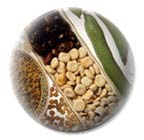- Home
- Introductions

|
Vegetable Seed Production: PrinciplesYou are here: Seed Production: Principles: Weed & Pest Management Weed and Pest Management The management of weeds and pests in vegetable seed production poses additional problems due to their longer growing season not encountered for vegetables grown for market. This extended growing period necessitates increased integrated pest management strategies or additional pesticide applications. In some cases, governmental regulations do not permit the use of the same pesticide for a vegetable seed crop that is used for the market use crop. This is because the approval process is directed at the more economically important value crop, which is usually the vegetable rather than the seed crop. Some pesticides that control insects also detrimentally affect insect pollinators essential for cross pollination or hybrid seed production and cannot be used in a seed production field. Such restrictions on the use of pesticides in vegetable seed production imply that the safe use of pesticides will be more difficult in the future and greater reliance on crop rotations and biological control measures. Also, production of organic seeds does not allow for synthetic chemical use. Insects and the timing of their infestations affect vegetable seed production. The Lygus bug prefers legume crops and safflower as its primary hosts. However, once these crops are harvested, the Lygus bugs commonly fly to adjacent carrot seed fields and rapidly create epidemic infestations. There, it feeds on developing seed embryos and subsequently reduces seed yield and quality. Cabbage looper is a significant pest of brassicas during vegetative development but does not affect seed stalk and pod development. Thus, control of this pest is important during vegetative growth if maximum yield and seed quality are to be attained. Aphids affect the harvest and subsequent conditioning of brassica seed crops by the development of "honeydew" which adheres to the seed pods and makes separation difficult and may attract other pests and diseases. Vegetable seed crops are susceptible to the same diseases as fresh market crops. However, the need to complete their entire life cycle for seed production means that other diseases may also be encountered and require control. Many significant diseases of vegetable seed crops can be controlled by growing the crop in differing geographic locations. For example, the low relative humidity and high temperatures of the southwestern United States reduce the incidence of the seedborne pathogen Cercospora carotae in carrot seed fields commonly found in the high relative humidity, low temperature Pacific Northwest. The incidence of downy mildew is reduced by growing long-day onion seeds in the low humidity areas of the desert southwestern United States.
Diseases in vegetable seed fields can also be minimized by separating the seed crop from disease pests either physically or over time. Physical separation occurs by producing the seed crop in an isolated region from fresh market crops or from the disease causing organism. Celery seed fields are isolated from celery stalk production fields to reduce the incidence of late blight caused by Septoria. Lettuce seed fields are isolated from leaf and head production fields to reduce the incidence of seed-borne lettuce mosaic virus. Isolation from the disease causing organism is achieved by maintaining weed-free irrigation canal banks and roadsides which serve as alternate hosts or growing the seed crop where the disease causing organism does not exist. To meet phytosanitary requirements for export, onion seed crops must be grown in regions where certain disease and nematodes are certified to be absent. The lettuce mosaic virus is another serious disease that results in unmarketable lettuce heads. To control this disease, an integrated pest management strategy has been established which focuses on the planting of disease-free seed and control of insects and weeds. Disease-free seed is achieved by planting stock seed in glass houses free of such virus vectors as the green peach aphid (Myzus persicae). Commercial seed lots are certified to have not more than one infected seed in 1,000 seeds that have been screened. Other effective measures include control of common weeds that serve as alternate hosts to insect vectors and frequent roguing of lettuce seed fields to remove any plants suspected of carrying the virus. Some disease causing organisms have relatively short life spans. In these cases, separation of the seed crop from the organism over time reduces disease problems. Alternating cabbage and other cruciferous seed crops in a three year rotation with non-cruciferous crops decreases the incidence of club root caused by Plasmodiophora brassicae. Nematodes can similarly be controlled in cucurbit and solanaceous seed crops by three year rotations with crops not from these families. In other cases, diseases can be controlled by storing the seed for a period during which the disease causing organism dies. An example is soft rot (Erwinia carotovora) on celery seeds which dies after two years of seed storage. Hot water baths or chemical treatments also control diseases. Hot water treatment is used on a variety of vegetable seeds to control a number of seedborne bacteria and fungi.
Many disease causing organisms are carried on the seed coat and most of these are controlled by various topical seed treatments consisting of fungicides, insecticides, and bactericides. Next: Cleaning & Storage |